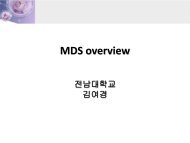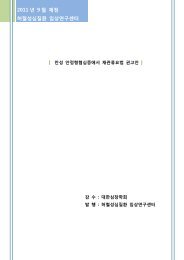Clinical
Clinical
Clinical
You also want an ePaper? Increase the reach of your titles
YUMPU automatically turns print PDFs into web optimized ePapers that Google loves.
THE ENDOCRINE SOCIETY’S CLINICAL GUIDELINES<br />
the two largest subsets of men with low testosterone<br />
levels—older men and men with chronic illness. The<br />
impact of untreated androgen deficiency on mortality is<br />
unclear (17). The benefits and adverse consequences of<br />
long-term testosterone therapy on patient-important<br />
outcomes in asymptomatic men with presumed<br />
hypogonadism remain unclear (5, 18). Therefore,<br />
screening for androgen deficiency does not fulfill any of<br />
the necessary criteria to justify it. No clinical trials have<br />
assessed the effectiveness of screening strategies.<br />
(Quality of evidence: )<br />
1.2.1.C VALUES<br />
The recommendation not to screen men in the general<br />
population places a high value on avoiding labeling and<br />
medicalization of otherwise healthy men for whom<br />
testing, treatment, and monitoring would represent a<br />
burden with unclear benefit. This recommendation also<br />
places a high value on avoiding interventions with<br />
unclear outcomes. It places a low value on the potential<br />
benefits of early detection and treatment of androgen<br />
deficiency in men who have not sought medical<br />
attention.<br />
1.2.2 Case Finding of Androgen Deficiency<br />
1.2.2.A RECOMMENDATIONS<br />
We suggest that clinicians not use the available casefinding<br />
instruments for detection of androgen deficiency in<br />
men receiving health care for unrelated reasons.<br />
(2| )<br />
We suggest that clinicians consider case detection by<br />
measurement of total testosterone levels in men with<br />
certain clinical disorders, listed in Table 3, in which the<br />
prevalence of low testosterone levels is high or for whom<br />
testosterone therapy is suggested/recommended in Section<br />
2.0. (2| )<br />
1.2.2.B EVIDENCE<br />
Ideally, case detection should identify from the clinic<br />
population patients who present with medical problems<br />
apparently unrelated to androgen deficiency, but who<br />
are likely to benefit from testosterone therapy.<br />
TABLE 3. Conditions in which there is a high<br />
prevalence of low testosterone levels and in which<br />
we suggest measurement of serum testosterone<br />
levels<br />
• Sellar mass, radiation to the sellar region, or other<br />
diseases of the sellar region<br />
• Treatment with medications that affect testosterone<br />
production or metabolism, such as glucocorticoids,<br />
ketoconazole, and opioids<br />
• HIV-associated weight loss<br />
• End-stage renal disease and maintenance<br />
hemodialysis<br />
• Moderate to severe chronic obstructive lung<br />
disease<br />
• Infertility<br />
• Osteoporosis or low trauma fracture, especially in<br />
a young man<br />
• Type 2 diabetes mellitus<br />
A high prevalence of low testosterone levels has been reported in men with<br />
several chronic disorders. This list is not exhaustive. Most surveys of men<br />
with chronic illness included relatively small, convenience samples. The<br />
information about the benefits and risks of testosterone therapy in these<br />
conditions is either limited or not available.<br />
Candidate groups in whom there is high prevalence of<br />
low testosterone levels and in whom we suggest<br />
measurement of serum testosterone level are listed in<br />
Table 3; these include men with chronic illness, such as<br />
those with HIV-associated weight loss, end-stage renal<br />
disease on dialysis, chronic obstructive pulmonary<br />
disease, osteoporosis or fracture after low trauma at a<br />
young age, type 2 diabetes mellitus, and men receiving<br />
chronic glucocorticoid and opioids (2, 22–25). Most<br />
surveys of men with chronic illness included relatively<br />
small, convenience samples. The information about the<br />
benefits and risks of testosterone therapy in these<br />
conditions is either limited or not available.<br />
There is limited information about the performance<br />
properties of case-detection instruments that rely on<br />
self-report, namely, Androgen Deficiency in Aging<br />
Males (ADAM) (19), the Aging Males’ Symptoms<br />
(AMS) Rating Scale (20), and the Massachusetts Male<br />
Aging Study Questionnaire (21). There are no trials of<br />
case-detection strategies in these patient populations,<br />
and the cost-effectiveness of the use of case-finding<br />
instruments over measurement of serum testosterone<br />
levels is unknown. (Quality of evidence: )<br />
8

















